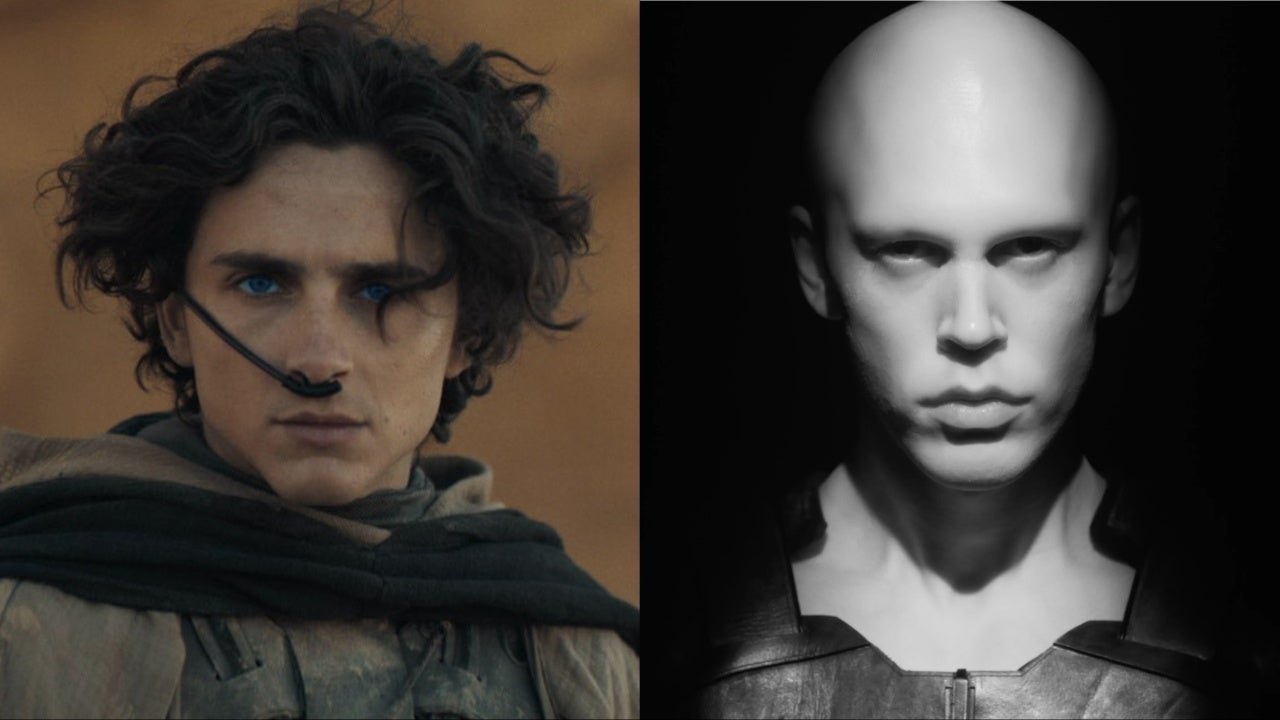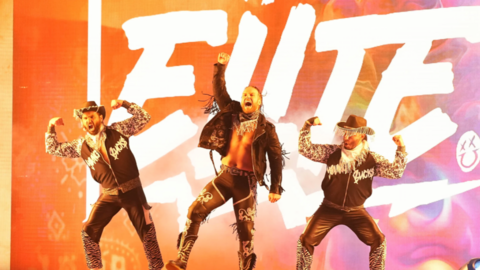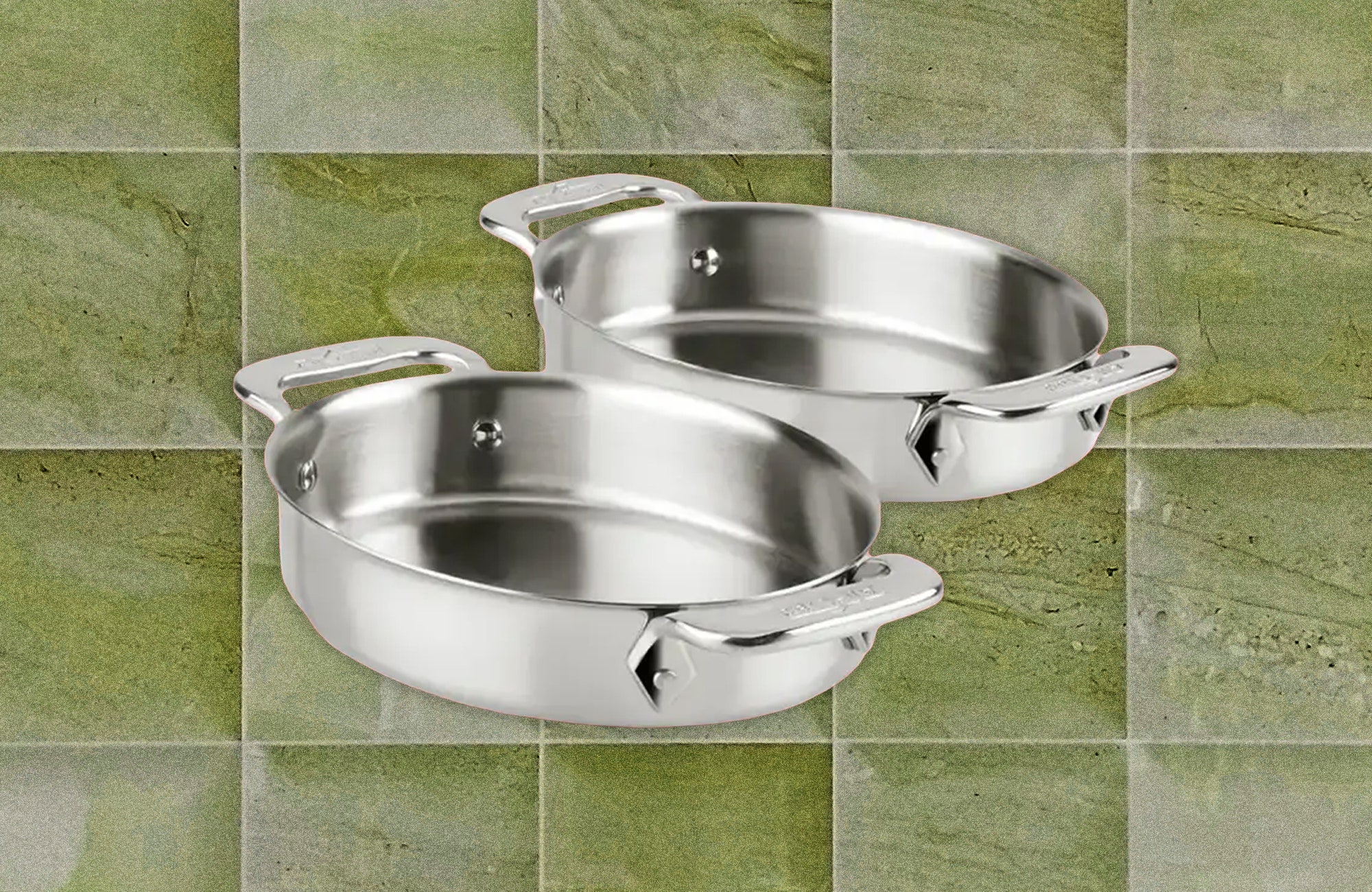Dune: Part 2 introduces a number of new characters to this epic sci-fi universe, but perhaps none more important than Austin Butler’s Feyd-Rautha Harkonnen. As if Timothée Chalamet’s Paul Atreides didn’t have enough enemies already, now he’s forced to face off with the heir apparent of House Harkonnen.
It’s safe to call Feyd-Rautha Paul’s arch-nemesis in the new movie. These two young men truly are two sides of the same coin. But what makes Feyd-Rautha the twisted mirror image of Paul? And how are both men connected by the Bene Gesserit and their centuries-long breeding program? Here’s what you need to know about the Paul/Feyd rivalry heading into the new Dune movie.
Who Is Austin Butler’s Feyd-Rautha?
Like his brother Glossu Rabban (played by Dave Bautista), Feyd-Rautha is the nephew of Stellan Skarsgard’s Baron Vladimir Harkonnen. Though he shares his brother and uncle’s bloodthirsty tendencies, Feyd could hardly be more different from Rabban. Where Rabban is known for his brutality and cruelty, earning him the nickname “Beast Rabban,” Feyd-Rautha is more subtle and cunningly sadistic.
That cunning is on full display with Feyd’s favorite pastime, dueling slaves in the gladiator arena. Feyd is one of the most skilled swordsmen in the entire universe, and he enjoys honing his abilities before a massive crowd. But though he has the talent to rival even men like Paul and Josh Brolin’s Gurney Halleck, Feyd isn’t the type of fighter to leave anything to chance, even if it means cheating. He’s notorious for coating his blades in poisons that leave his opponents paralyzed or writhing in unimaginable pain. He’ll even take advantage of hypnotically planted codewords that can shut his opponents’ bodies down at a single command. Whatever it takes to win the fight and look good in front of a crowd.
It’s that cunning that makes Feyd so attractive a candidate as heir to Baron Harkonnen. The Baron has no wife and children of his own, leading him to effectively adopt his brother Abulurd’s two sons instead. The Baron molds the two men in his own image, twisting them in ways that would never have been possible if they were raised by the more honorable Abulurd. In fact, Rabban wound up murdering his father with his bare hands, which is how he originally acquired the Beast Rabban nickname in the first place.
The Baron sees in Feyd a young man with the potential to succeed him and even ascend the Imperial throne. Cementing House Harkonnen’s place at the top of the galactic food chain is really the Baron’s ultimate goal in Dune, even if he himself won’t be the one to become Emperor. Getting revenge against House Atreides and settling their ancient feud is just icing on the spice cake.
In Dune: Part 2, Feyd enters the stage as a possible replacement to take over the stewardship of Arrakis. Historically, the Baron has relied on Raban to enforce his will and keep the supply of spice flowing by any means necessary. The Baron hopes that by replacing Rabban with Feyd-Rautha, the citizens of Arrakis will look to Feyd as their savior. Anything beats toiling away under the iron grip of Beast Rabban.
That’s not to say Feyd and his uncle are in perfect lockstep with one another. Feyd is young and impulsive. He understands his uncle holds the key to great power and wealth, but he lacks the patience to fully appreciate the Baron’s complex, far-reaching plans. His uncle is both the key to Feyd’s rise and an obstacle standing in his way. Dune was doing Game of Thrones decades before Game of Thrones was a thing, so expect plenty of conflict among family members as the sequel unfolds. But ultimately, Feyd’s true enemy isn’t his uncle, but the young heir to House Atreides.
The Kwisatz Haderach in the Dune Universe
Paul Atreides and Feyd-Rautha Harkonnen are linked in more ways than one. Sure, they’re both young men who happen to be good with a blade and who represent the future of their respective houses, but there’s more to it than that. Paul and Feyd are both the result of a centuries-long effort to produce the ultimate cosmic messiah known as the Kwisatz Haderach.
Creating the Kwisatz Haderach is the ultimate goal of the Bene Gesserit Sisterhood. The name roughly translates to “the one who can be many places at once." The Kwisatz Haderach is a male Bene Gesserit with the ability to access the genetic memories of both his male and female ancestors, effectively breaking down the barriers between space and time and creating the perfect superhuman that can guide the galaxy forward.
Creating a Kwisatz Haderach is far easier said than done, however. The Sisterhood has been hard at work for many generations, orchestrating a complex breeding program where Bene Gesserit sisters are paired with men with desirable genetic traits. Little by little, the sisters hope to create the building blocks for their Kwisatz Haderach.
By the time of the Dune movie, the breeding program should have reached its final stage. The sisters calculate that the process will be complete when an Atreides daughter is wed to Feyd-Rautha. There’s just one problem. Rebecca Ferguson’s Lady Jessica was supposed to produce that daughter with Oscar Isaac’s Duke Leto. Instead, Jessica gave into Leto’s desire for a son, throwing the entire breeding program into disarray.
That’s why we see Charlotte Rampling’s Gaius Helen Mohaim testing Paul at the beginning of the first movie. Reverend Mother Mohaim is desperate to learn if their breeding program can be salvaged. Can Paul’s offspring still become the Kwisatz Haderach? Could Paul himself be the Kwisatz Haderach? The answers are unclear at the time, but over the course of the film, it becomes obvious that Paul is coming to grips with a great and terrible power.
This is why the stakes are so high as Paul and Feyd-Rautha begin their great feud in Dune: Part 2. Both men are at the mercy of forces far greater than them. They’re both the result of centuries of careful planning and breeding and preparation. They’re both at the end stages of a long effort to produce a messiah who can reshape the galaxy. If either one dies, it could set the Sisterhood’s breeding program back decades or even centuries.
This is also where Lea Seydoux’s character Lady Margot Fenring comes in. Lady Margot is another high-ranking member of the Bene Gesserit, and one committed to seeing the breeding program through to its conclusion. Margot is tasked with seducing Feyd in the hope of salvaging his genetic material. If he can’t father the Kwisatz Haderach, then hopefully he can still be a building block toward the messiah. That’s the hope, anyway. We’ll see what comes of this potential union in Dune: Part 2.
Paul vs. Feyd in Dune 1984
Feyd-Rautha may be the twisted antithesis of Paul Atreides, but the two characters have yet to actually meet in Denis Villeneuve’s Dune universe. Feyd himself doesn’t appear in the first movie, and if the sequel is anything like the book or the various other adaptations, he and Paul won’t cross blades until the very end of Dune: Part 2.
There’s not really room to have the characters meet before then. As Dune: Part 2 opens, Paul is living among the Fremen and building the legend that will soon carry his new people to a holy war against the Imperium. Meanwhile, Feyd is living on Giedi Prime with his uncle and perfecting his abilities in the arena. As far as Feyd and his family are concerned, Paul died during the sneak attack on House Atreides.
Even though these characters don’t meet until the very end of their shared story, their rivalry remains one of the most iconic and memorable parts of the Dune saga in all its forms. That’s thanks in no small part to David Lynch’s 1984 adaptation, which features Kyle MacLachlan as Paul and the musician Sting as Feyd. The movie culminates in a tense duel between the heirs of Houses Atreides and Harkonnen, all while the gathered forces of the Fremen and the Imperium look on.
Dune 1984 may be an imperfect adaptation at best, but Sting’s performance as Feyd remains one of the most beloved elements of the film. It’s a scenery-chewing performance in a film full of over-the-top acting. And there’s just something about the sinewy, calculating and charismatic Feyd-Rautha that calls for a rock star to play him. Not only does Sting play Feyd in the 1984 version, director Alejandro Jodorowsky eyed Mick Jagger to play Feyd in his doomed adaptation. Even in Dune: Part 2, Butler is probably best known for playing Elvis Presley 2022’s Elvis. The tradition lives on.
Now that Dune: Part 2 is nearly here, we’ll once again see what happens when two of the deadliest fighters in the galaxy finally duel. Can Paul, trained by two of the best swordsmen in the Imperium and gifted with the powers of prescience, defeat Feyd-Rautha in one-on-one battle? Or will Feyd, with his equally deadly skill and his penchant for cheating, triumph over the supposed Kwisatz Haderach? Great and mysterious forces have been maneuvering these two men into mortal combat, and we’re about to see what happens when they cross blades.
What are you most excited to see in Dune: Part 2? Let us know in the comments. And for more on the sequel, read IGN's Dune: Part 2 review and see the film's cast react to that disturbing popcorn bucket.
Jesse is a mild-mannered staff writer for IGN. Allow him to lend a machete to your intellectual thicket by following @jschedeen on Twitter.









